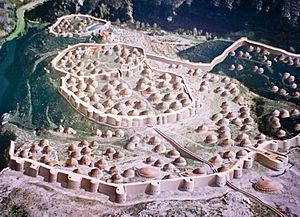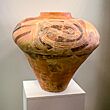Chalcolithic Europe facts for kids
The European Chalcolithic was a time in Prehistoric Europe. It is also called the Copper Age. This period lasted from about 5000 BC to 2000 BC. It came after the Stone Age and before the Bronze Age.
During this time, people started using copper. They also built huge stone structures called Megaliths. Society began to change, with some people becoming richer or more powerful. It's also thought that early speakers of Indo-European languages (like the ancestors of English or Spanish) first appeared in Europe then.
The way people lived changed a lot. Even where copper wasn't used, communities weren't just small farming villages anymore. Some goods were made in special places. Then they were traded far and wide. People started mining metals and stones. They turned these materials into valuable items.
Early Copper Age in Europe
From about 5000 BC to 3000 BC, people in Southeast Europe first started using copper. Then, this new skill spread to Eastern and Central Europe. Around 3500 BC, new groups of people arrived in Eastern Europe. They came from the Pontic–Caspian steppe. These groups formed the Sredny Stog culture. They moved northwest towards the Baltic Sea and Denmark. There, they mixed with local people. This movement might be linked to how Indo-European languages spread.
Meanwhile, in the Danubian region, the Lengyel culture grew. It spread into the Czech Republic and Poland. In Bulgaria and Southern Romania, the Boian-Marica culture became very powerful. They even had a royal cemetery near the Black Sea coast. This shows that some leaders were very important. People started doing special jobs, like mining or crafting. This led to some people having more wealth. This might have been because of trade or the risk of invasions.
In Western Europe, the Michelsberg culture became important. In the Mediterranean, several cultures worked together. They created a network to trade honey-coloured flint. Even with this trade, there were conflicts. Many skeletons from this time show signs of violent injuries. This was when Ötzi, the famous "Iceman," lived in the Alps. Another big change was the spread of Megalithic structures. These huge stone monuments appeared across the Atlantic region. They also brought farming to some areas that didn't have it yet.
-
Varna culture artefacts, 4500 BC
-
Cucuteni-Trypillia figurine, 4000 BC
-
Ljubljana Wheel, Slovenia, 3150 BC
Middle Copper Age in Europe

This period covers the first half of the 3rd millennium BC. A powerful group called the Baden culture grew in the Danubian region. It spread across a large area. The rest of the Balkans changed a lot after earlier movements of people. However, most groups there did not show signs of "eastern" influences. A new culture in Bulgaria, the Ezero culture, started using a mix of copper and arsenic. This was an early form of bronze. The Cycladic culture in the Aegean Sea also started using this mix around 2800 BC.
In the north, groups thought to be Indo-European seemed to shrink. They adopted more Danubian ways of life. In the east, people from beyond the Volga River, the Yamnaya culture, took over southern Russia and Ukraine. These were likely eastern Indo-Europeans. In the west, the Megalithic culture continued to spread. It reached from southern Sweden to southern Spain. But other groups in the Mediterranean and Danubian areas broke into smaller pieces. Some of these smaller groups seemed to fall behind in technology.
After 2600 BC, new changes began. Large towns with stone walls appeared in Spain. One was in Portugal, part of the Atlantic Megalithic culture. The other was Los Millares in southeast Spain. This town had a Mediterranean style. It might have been influenced by eastern cultures. Even with differences, these two groups seemed to be friendly and traded with each other.
In France, a new culture of archers appeared. This was the Artenac culture. They soon took control of western and northern France and Belgium. In Poland, the Indo-European groups became stronger again. They formed the Globular Amphoras culture. However, living near the powerful Danubian peoples for centuries had changed their culture a lot.
In southwestern Spain, unique owl-shaped plaques were found. They were made of sandstone between 5500 and 4750 years ago. These plaques usually have a head, two round eyes, and a body. They were shaped like two types of owls: the little owl and the long-eared owl.
Late Copper Age in Europe

This period lasted from about 2500 BC to 1800 or 1700 BC. The Aegean region was already in the Bronze Age by this time. Around 2500 BC, the new Catacomb culture appeared. It came from the Yamnaya people near the Black Sea. Some of these people moved into Poland. They might have helped change the Globular Amphorae culture into the new Corded Ware culture. In Britain, copper was used between 2500 BC and 2200 BC. But some experts don't call it a British Chalcolithic. This is because copper use was very small there.
Around 2400 BC, the Corded Ware people replaced earlier groups. They spread into western Germany and Nordic areas. One group moved into Denmark and southern Sweden. In the middle Danubian area, new Indo-European leaders appeared. This was the Vučedol culture. At the same time, the Artenac people reached Belgium. Most of the Danubian cultures, which were strong before, disappeared from the map.
The rest of this period is known for the mysterious Beaker people. This group seemed to be traders. They had a very specific way of burying their dead. Outside their original area, they appeared within local cultures. This means they didn't invade and take over. Instead, they lived among other peoples, keeping their own traditions.
The rest of Europe stayed mostly peaceful and unchanged. Around 2300 BC, the first Beaker Pottery appeared in Bohemia. It spread in many directions, especially west. It reached Portugal and Spain. At the same time, around 2200 BC, the Cycladic culture in the Aegean declined. It was replaced by the new Minoan civilization on the island of Crete.
The second phase of Beaker Pottery started around 2100 BC. The main center for this pottery moved to Portugal. Its influence reached southern and western France. After 1900 BC, the center of Beaker Pottery moved back to Bohemia. In Spain, there were new centers in Portugal, Los Millares, and Ciempozuelos.
See also
- Bronze Age Europe
- Metallurgy during the Copper Age in Europe
- Burned house horizon








